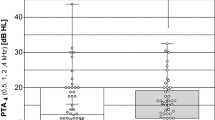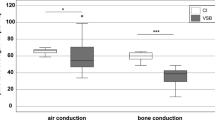Abstract
Transtympanic promontory stimulation test (TPST) has been suggested to be a useful tool in predicting postoperative outcomes in patients at risk of poor auditory neuron functioning, especially after a long auditory deprivation. However, only sparse data are available on this topic. This study aimed at showing correlations between the auditory nerve dynamic range, evaluated by TPST, the electrical dynamic range of the cochlear implant and speech perception outcome. We evaluated 65 patients with postlingual hearing loss and no residual hearing, implanted with a Nucleus CI24 cochlear implant device for at least 2 years and with a minimum of 17 active electrodes. Using the TPST, we measured the threshold for auditory perception (T-level) and the maximum acceptable level of stimulation (M-level) at stimulation frequencies of 50, 100 and 200 Hz. General linear regression was performed to correlate 1/speech perception, evaluated using the PBK test 1 year after surgery, and 2/cochlear implant electrical dynamic range, with the age at time of implantation, the duration of auditory deprivation, the etiology of the deafness, the duration of cochlear implant use and auditory nerve dynamic range. Postoperative speech perception outcome correlated with etiology, duration of auditory deprivation and implant use, and TPST at 100 and 200 Hz. The dynamic range of the cochlear implant map correlated with duration of auditory deprivation, speech perception outcome at 6 months and TPST at 100 and 200 Hz. TPST test can be used to predict functional outcome after cochlear implant surgery in difficult cases.

Similar content being viewed by others
References
Di Nardo W, Scorpecci A, Giannantonio S et al (2011) Improving melody recognition in cochlear implant recipients through individualized frequency map fitting. Eur Arch Otorhinolaryngol 268:27–39
Boyd P, Euthymiades A (2009) Comparison of loudness adjustments by MCL and maplaw in users of the MED-EL COMBI 40/40+ cochlear implant system. Cochlear Implants Int 10:203–217
Blamey PJ, Pyman BC, Gordon M et al (1992) Factors predicting postoperative sentence scores in postlinguistically deaf adult cochlear implant patients. Ann Otol Rhinol Laryngol 101:342–348
Kuo SC, Gibson WP (2002) The role of the promontory stimulation test in cochlear implantation. Cochlear Implants Int 3:19–28
Lee JC, Yoo MH, Ahn JH et al (2007) Value of the promontory stimulation test in predicting speech perception after cochlear implantation. Laryngoscope 117:1988–1992
Cosendai G, Pelizzone M (2001) Effects of the acoustical dynamic range on speech recognition with cochlear implants. Audiology 40:272–281
Dawson PW, Decker JA, Psarros CE (2004) Optimizing dynamic range in children using the nucleus cochlear implant. Ear Hear 25:230–241
Spahr AJ, Dorman MF, Loiselle LH (2007) Performance of patients using different cochlear implant systems: effects of input dynamic range. Ear Hear 28:260–275
van Hoesel R, Bohm M, Battmer RD et al (2005) Amplitude-mapping effects on speech intelligibility with unilateral and bilateral cochlear implants. Ear Hear 26:381–388
Pfingst BE (1988) Comparisons of psychophysical and neurophysiological studies of cochlear implants. Hear Res 34:243–251
Waltzman SB, Cohen NL (1998) Cochlear implantation in children younger than 2 years old. Am J Otol 19:158–162
Schuknecht HF, Merchant SN, Nadol JB (2010) Schuknecht’s pathology of the ear. People’s Medical Pub. House-USA, Shelton
Kileny PR, Zimmerman-Phillips S, Kemink JL et al (1991) Effects of preoperative electrical stimulability and historical factors on performance with multichannel cochlear implant. Ann Otol Rhinol Laryngol 100:563–568
Black J, Hickson L, Black B et al (2011) Prognostic indicators in paediatric cochlear implant surgery: a systematic literature review. Cochlear Implants Int 12:67–93
Green KM, Bhatt YM, Mawman DJ et al (2007) Predictors of audiological outcome following cochlear implantation in adults. Cochlear Implants Int 8:1–11
Albu S, Babighian G (1997) Predictive factors in cochlear implants. Acta Otorhinolaryngol Belg 51:11–16
Kileny PR, Zwolan TA, Zimmerman-Phillips S et al (1992) A comparison of round-window and transtympanic promontory electric stimulation in cochlear implant candidates. Ear Hear 13:294–299
Ohlemiller KK, Echteler SM, Siegel JH (1991) Factors that influence rate-versus-intensity relations in single cochlear nerve fibers of the gerbil. J Acoust Soc Am 90:274–287
Winter IM, Robertson D, Yates GK (1990) Diversity of characteristic frequency rate–intensity functions in guinea pig auditory nerve fibres. Hear Res 45:191–202
O’Gorman DE, White JA, Shera CA (2009) Dynamical instability determines the effect of ongoing noise on neural firing. J Assoc Res Otolaryngol 10:251–267
Kreft HA, Donaldson GS, Nelson DA (2004) Effects of pulse rate on threshold and dynamic range in Clarion cochlear-implant users. J Acoust Soc Am 115:1885–1888
Shim Y, Kim H, Change M et al (1995) Map dynamic ranges versus duration of hearing loss in cochlear implantees. Ann Otol Rhinol Laryngol Suppl 166:178–180
Firszt JB, Chambers RD et al (2002) Neurophysiology of cochlear implant users II: comparison among speech perception, dynamic range, and physiological measures. Ear Hear 23:516–531
Viemeister NF (1988) Intensity coding and the dynamic range problem. Hear Res 34:267–274
Davidson LS, Skinner MW, Holstad BA et al (2009) The effect of instantaneous input dynamic range setting on the speech perception of children with the nucleus 24 implant. Ear Hear 30:340–349
Blamey PJ (2005) Adaptive dynamic range optimization (ADRO): a digital amplification strategy for hearing aids and cochlear implants. Trends Amplif 9:77–98
Alvarez I, de la Torre A, Sainz M et al (2010) Using evoked compound action potentials to assess activation of electrodes and predict C-levels in the Tempo+ cochlear implant speech processor. Ear Hear 31:134–145
Holstad BA, Sonneveldt VG, Fears BT et al (2009) Relation of electrically evoked compound action potential thresholds to behavioral T- and C-levels in children with cochlear implants. Ear Hear 30:115–127
Potts LG, Skinner MW, Gotter BD et al (2007) Relation between neural response telemetry thresholds, T- and C-levels, and loudness judgments in 12 adult nucleus 24 cochlear implant recipients. Ear Hear 28:495–511
Walkowiak A, Lorens A, Polak M et al (2011) Evoked stapedius reflex and compound action potential thresholds versus most comfortable loudness level: assessment of their relation for charge-based fitting strategies in implant users. ORL J Otorhinolaryngol Relat Spec 73:189–195
Nikolopoulos TP, Mason SM, Gibbin KP et al (2000) The prognostic value of promontory electric auditory brain stem response in pediatric cochlear implantation. Ear Hear 21:236–241
Hoth S, Lenarz T (1991) Experience with electrostimulation of the acoustic nerve before cochlea implantation. Laryngorhinootologie 70:199–207
Brokx JP, Hombergen G, Coninx F (1988) Relations between audiometrical thresholds of potential cochlear implant patients and their performance in preoperative psycho-physical tests with electrical stimulation. Scand Audiol 17:217–222
Author information
Authors and Affiliations
Corresponding author
Rights and permissions
About this article
Cite this article
Alfelasi, M., Piron, J.P., Mathiolon, C. et al. The transtympanic promontory stimulation test in patients with auditory deprivation: correlations with electrical dynamics of cochlear implant and speech perception. Eur Arch Otorhinolaryngol 270, 1809–1815 (2013). https://doi.org/10.1007/s00405-012-2125-1
Received:
Accepted:
Published:
Issue Date:
DOI: https://doi.org/10.1007/s00405-012-2125-1




